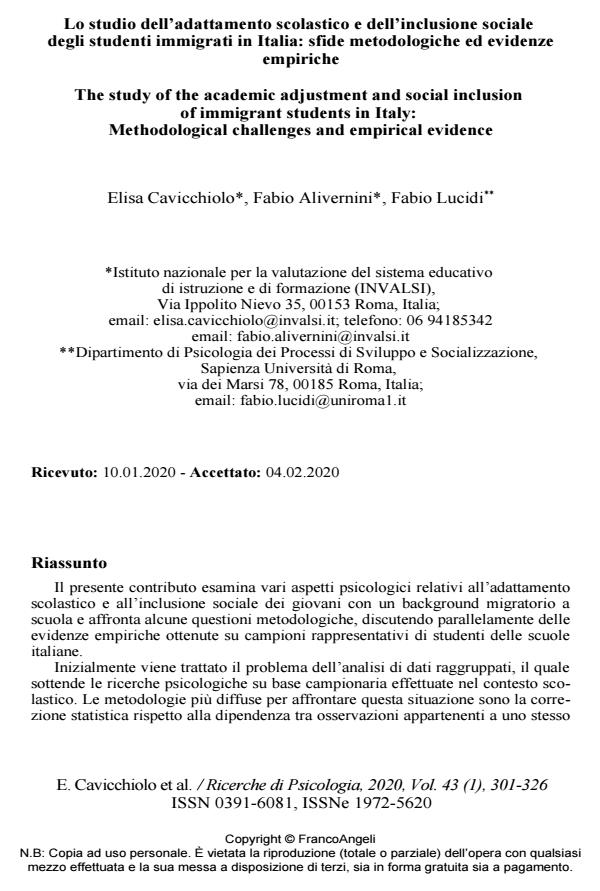Lo studio dell’adattamento scolastico e dell’inclusione sociale degli studenti immigrati in Italia: sfide metodologiche ed evidenze empiriche
Titolo Rivista RICERCHE DI PSICOLOGIA
Autori/Curatori Elisa Cavicchiolo, Fabio Alivernini, Fabio Lucidi
Anno di pubblicazione 2020 Fascicolo 2020/1
Lingua Italiano Numero pagine 26 P. 301-326 Dimensione file 283 KB
DOI 10.3280/RIP2020-001014
Il DOI è il codice a barre della proprietà intellettuale: per saperne di più
clicca qui
Qui sotto puoi vedere in anteprima la prima pagina di questo articolo.
Se questo articolo ti interessa, lo puoi acquistare (e scaricare in formato pdf) seguendo le facili indicazioni per acquistare il download credit. Acquista Download Credits per scaricare questo Articolo in formato PDF

FrancoAngeli è membro della Publishers International Linking Association, Inc (PILA)associazione indipendente e non profit per facilitare (attraverso i servizi tecnologici implementati da CrossRef.org) l’accesso degli studiosi ai contenuti digitali nelle pubblicazioni professionali e scientifiche
Il presente contributo esamina vari aspetti psicologici relativi all’adattamento scolastico e all’inclusione sociale dei giovani con un background migratorio a scuola e affronta alcune questioni metodologiche, discutendo parallelamente delle evidenze empiriche ottenute su campioni rappresentativi di studenti delle scuole italiane. Inizialmente viene trattato il problema dell’analisi di dati raggruppati, il quale sottende le ricerche psicologiche su base campionaria effettuate nel contesto scolastico. Le metodologie piu diffuse per affrontare questa situazione sono la correzione statistica rispetto alla dipendenza tra osservazioni appartenenti a uno stesso gruppo e l’analisi multilivello. La scelta di quale approccio utilizzare dovrebbe basarsi sulle domande di ricerca, ad esempio valutando se esse sono poste a livello individuale o di gruppo. Successivamente e stata presa in considerazione la questione metodologica posta dal condurre indagini a scuola su tematiche sensibili, dove puo risultare problematico l’utilizzo esclusivo di domande chiuse. In questi casi strumenti che contengano domande aperte basate su metafore hanno il vantaggio di consentire agli studenti di utilizzare le loro parole e la loro esperienza, permettendo cosi di trattare in maniera indiretta argomenti delicati. Le evidenze empiriche discusse nel presente contributo rispetto all’adattamento scolastico, mostrano come uno studente immigrato nella scuola primaria risulti essere, in media, piu e meglio motivato nello studio rispetto agli altri studenti. Allo stesso tempo, nella scuola secondaria, chi ha un background migratorio risulta adottare strategie cognitive di studio meno autoregolate e piu superficiali. In entrambi i casi la generazione di appartenenza dello studente risulta essere un elemento rilevante, con le prime generazioni che presentano un pattern, paradossalmente, piu adattivo. Rispetto all’inclusione, i risultati evidenziano come un allievo con un background migratorio, sia, in classe, meno accettato e abbia meno amici degli altri studenti. Inoltre e piu spesso vittima di comportamenti aggressivi a scuola. Contrariamente a quanto visto per l’adattamento scolastico, si assiste per l’inclusione a una attenuazione da una generazione all’altra delle problematiche riscontrate. Infine, per quello che riguarda gli atteggiamenti nei confronti degli immigrati, spesso visti in stretta connessione con comportamenti di natura discriminatoria, le evidenze empiriche mostrano percezioni degli studenti che dal punto di vista cognitivo ed emotivo non appaiono riducibili a una semplice dicotomia positivo/negativo.
Parole chiave:Analisi dati raggruppati, metafore, adattamento scolastico, inclusione sociale, benessere a scuola, atteggiamenti verso gli immigrati.
- Migrazioni e psicologie. Introduzione al Forum Alessandro Antonietti, Antonella Marchetti, in RICERCHE DI PSICOLOGIA 1/2020 pp.13
DOI: 10.3280/RIP2020-001002
Elisa Cavicchiolo, Fabio Alivernini, Fabio Lucidi, Lo studio dell’adattamento scolastico e dell’inclusione sociale degli studenti immigrati in Italia: sfide metodologiche ed evidenze empiriche in "RICERCHE DI PSICOLOGIA " 1/2020, pp 301-326, DOI: 10.3280/RIP2020-001014